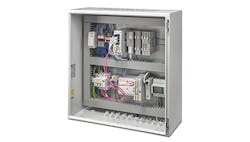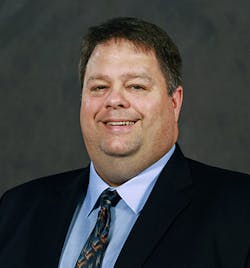Machine controls get smarter faster
Ted Thayer is principal product marketing specialist, control, at Phoenix Contact.
What have been the biggest improvements to machine-control technology in the past five years?
Ted Thayer, principal product marketing specialist, control, Phoenix Contact: The improvements in processor power and memory have been astounding. I remember teaching PLC programming back in the 2000s and was showing techniques, such as placement of infrequently “true” contacts near the front of a rung to improve program scan. We are way beyond that sort of approach being necessary.
What’s the most innovative or efficient machine-control technology application you’ve ever seen or been involved with?
Ted Thayer, principal product marketing specialist, control, Phoenix Contact: I am studying machine learning right now. I have a long way to go yet, but the potential—improved network security, ever-improving batch production, substance analysis—is revolutionary. And yet the technology can be implemented by anyone with a basic understanding of Python.
How has machine-control technology benefitted from remote monitoring and connectivity?
Ted Thayer, principal product marketing specialist, control, Phoenix Contact: The easy answer is improvement in uptime and faster responses to downtime. Being able to monitor systems remotely and flag concerning situations—vibration and heat sensors have been good for proactive/predictive maintenance—has certainly help keep systems running. And being able to connect and troubleshoot a program from the home office, without the commute, also reduces downtime.
Can you explain how software development has changed machine controls in discrete manufacturing?
Ted Thayer, principal product marketing specialist, control, Phoenix Contact: Software has become much more collaborative. More engineers working in parallel, rather than in series equals faster development time. I also think the adoption of IEC-61131 standards, with the ability to mix programming styles, create your own instructions and name variables with easy-to-understand names, has also resulted in programs that can be written faster, are somewhat self-documenting and are easy to understand. Also, the rise of computer-program languages in industrial automation, such as Python, will lead to more compact programs and access to a new talent pool of programmers.
How do control technologies figure into digital-twin platform models being used by manufacturers?
Ted Thayer, principal product marketing specialist, control, Phoenix Contact: There are PLCs available that not only do machine control but can also function as an edge device and log data to a cloud or local database. I feel that this type of product would be the ideal foundation for doing digital twinning. What better device to supply data to an information model than the actual device running the process?
When will machine controls become IT-friendly enough that engineers are no longer required for installation and operation?
Ted Thayer, principal product marketing specialist, control, Phoenix Contact: With the interaction between the program environment and the real world of sensors and drives, I’m not sure that you will ever be able to remove the engineer from the equation. If that does happen, I hope it’s after I’ve retired, or I would be out of a job. I do think the appearance of apps in automation, and low-code options such as Blockly, could open program development to non-engineers eventually.
What future innovations will impact the use of machine-control technology in discrete-manufacturing operations?
Ted Thayer, principal product marketing specialist, control, Phoenix Contact: I can see that the embedding of intelligence into devices, as well as improved lightweight securable communications, such a MQTT, could reduce the need for powerful PLCs to run systems (Figure 1). This could lead to a rise in devices, such as edge computers, to function as traffic cops.
Tell us about your company’s state-of-the-art machine-control technology for discrete manufacturing.
Ted Thayer, principal product marketing specialist, control, Phoenix Contact: PLCnext Technology is a new approach to automation that provides an IIoT-ready platform with open programming. Phoenix Contact provides a free software package—PLCnext Engineer, if you wish to program in a ladder logic/structured text environment. This software is IEC-61131-compliant, so you can use a mix of programming languages, easy-to-understand device name and instructions that you can make to create a powerful, easy-to-understand program. PLCnext Engineer also allows you to build an HMI that is part of the overall program. But, if you wish, you can program in a number of other software packages—C++, C#, Java, Python, Node-Red, even CoDeSys. You can program with the language you want, and even mix languages. I have seen some amazing applications done with Python in conjunction with ladder. Being IIoT-ready, we can connect to a cloud with just a few clicks, and we can connect safely because our 16 years in network security with the mGuard product line has taught us a few concepts that have been deployed in PLCnext.
Mike Bacidore is the editor in chief for Control Design magazine. He is an award-winning columnist, earning a Gold Regional Award and a Silver National Award from the American Society of Business Publication Editors. Email him at [email protected].
About the Author
Mike Bacidore
Editor in Chief
Mike Bacidore is chief editor of Control Design and has been an integral part of the Endeavor Business Media editorial team since 2007. Previously, he was editorial director at Hughes Communications and a portfolio manager of the human resources and labor law areas at Wolters Kluwer. Bacidore holds a BA from the University of Illinois and an MBA from Lake Forest Graduate School of Management. He is an award-winning columnist, earning multiple regional and national awards from the American Society of Business Publication Editors. He may be reached at [email protected]

Leaders relevant to this article:



